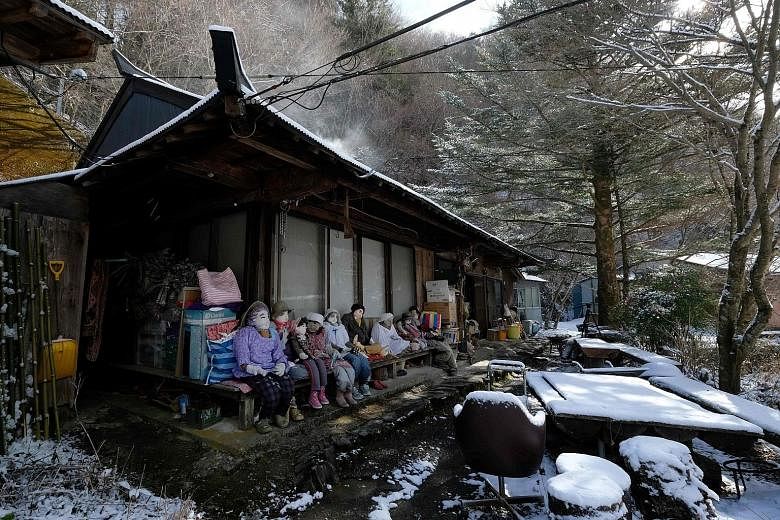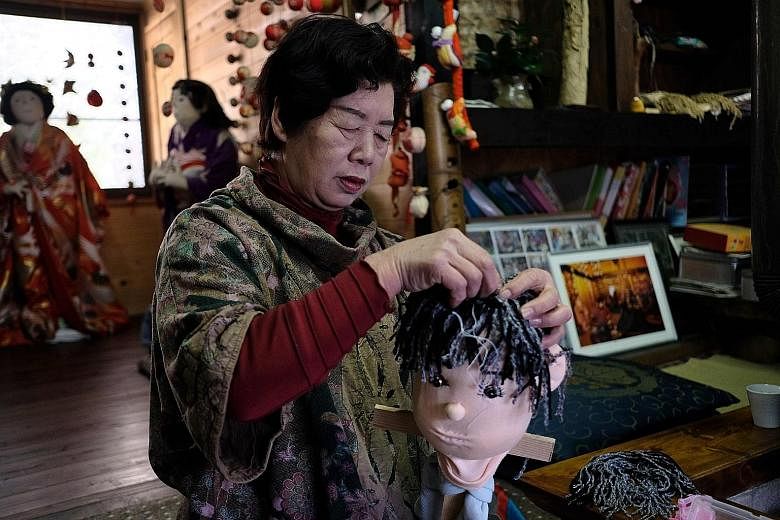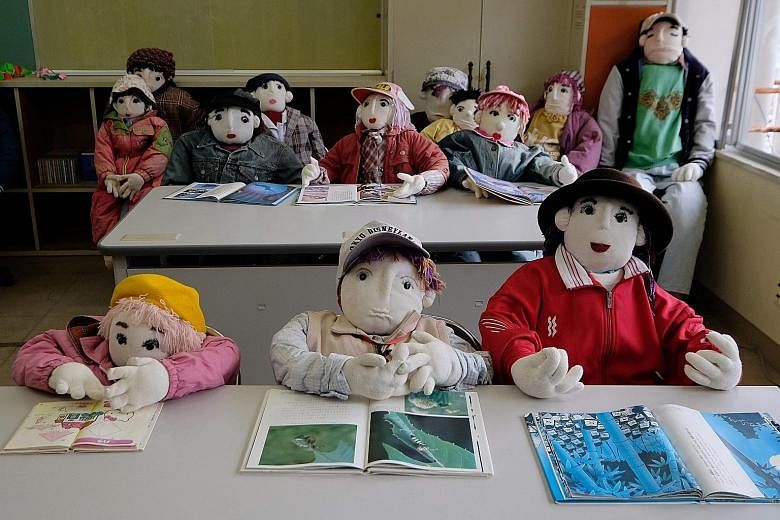NAGORO, JAPAN • In the tiny village of Nagoro, deep in the mountains of western Japan, the wind howls down a deserted street with not a living soul to be seen.
But yet the street appears busy, dotted with life-sized dolls that outnumber humans 10 to one, the product of a one-woman bid to counter the emptiness and loneliness felt in Nagoro, like many Japanese villages decimated by depopulation.
Nagoro, about 550km south-west of Tokyo, has become known as the "valley of dolls" after local resident Tsukimi Ayano began placing scarecrows on the street to inject some life into her depopulated village.
"Only 27 people live in this village but the number of scarecrows is tenfold, like 270," the 69-year-old doll-maker said in an interview at her home.
It all started 16 years ago when the dexterous Ms Ayano created a scarecrow dressed in her father's clothes to prevent birds from eating the seeds she had planted in her garden.
"A worker who saw it in the garden thought it really was my father... He said 'hello' but it was a scarecrow. It was funny," recalled Ms Ayano.
Since then, she has not stopped creating the life-sized dolls, made with wooden sticks, newspapers to fill the body, elastic fabric for skin and knitting wool for hair.
She needs only three days to make an adult-sized doll. Many of them are now scattered all around the village.
The secret to breathing life into the dolls? Applying pink colour to the lips and cheeks with a make-up brush, said Ms Ayano.
At the local school, she has placed 12 colourful child-sized dolls at desks, positioned as if they are part of a lively class poring over their books.
The school closed seven years ago as there was no one left to teach, she recalled sadly. "Now there are no children. The youngest person here is 55 years old."
Down the street, a "family" of scarecrows lounges in front of an abandoned grocery shop while a doll dressed as an old farmer window-shops next door. Near the bus stop, a group of scarecrows gathers as another "father" doll pulls a cart full of "children".
Ms Ayano remembers that when she was a child, Nagoro was once a thriving village with about 300 residents and labourers working in the forestry industry and dam construction. "People gradually left. It's lonely now," she said. "I made more dolls as I remembered the time when the village was a lively place."
Nagoro's plight is replicated around Japan, as the world's third-largest economy battles a declining population, low birth rate and high life expectancy.
The country is on the verge of becoming the first "ultra-aged" country in the world, meaning that 28 per cent of people are aged 65 or above.
The latest government report shows that 27.7 per cent of a population of 127 million - one in four people - are aged 65 or older and the figure is expected to jump to 37.7 per cent in 2050.
According to experts, around 40 per cent of Japan's 1,700 municipalities are defined as "depopulated".
After World War II, when forestry and agriculture were the main economic drivers, many Japanese lived in rural villages like Nagoro. But young people started to leave for Tokyo in the 1960s, said Mr Takumi Fujinami, an economist from the Japan Research Institute.
"The economy was booming in Tokyo and industrial areas at that time. They were the only places people could earn money, so a lot of young people moved there," he said.
Prime Minister Shinzo Abe has pledged to revive regions outside Tokyo by pumping in tens of billions of yen, but this is not enough to stop young people from leaving their hometowns to work in Tokyo, said Mr Fujinami.
He added: "In order to combat depopulation, we need people moving in to depopulated areas. But recovering the population is extremely difficult.
"Instead, it's important to increase income or improve working conditions for young people in rural areas." For example, firms in rural areas tend to have fewer holidays than those in Tokyo, he said.
"We need to create communities where young people can make a long-term living," Mr Fujinami said, adding that subsidising them to move in is not enough.
While there is little evidence of citizens returning to Nagoro, Ms Ayano's dolls have attracted people from as far as the United States and France.
"Before I started making scarecrows, nobody stopped by. Now, many people visit this place," she said. I hope Nagoro will become lively again and many people come here for sightseeing," she said.
"I don't know what Nagoro will look like in 10 or 20 years, but I'll keep on making dolls."
AGENCE FRANCE-PRESSE



